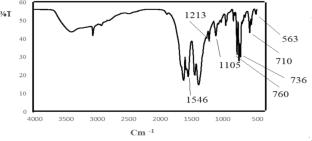A bimetallic yttrium-zinc-based metal−organic framework as an efficient platform for voltammetric sensing epinephrine in the presence of acetaminophen
Abstract
Determination of pharmaceutical compounds and biological species in real samples is of significant importance and has been widely considered in recent years. In this work, a voltammetric sensor has been designed for detecting epinephrine (EP). This sensor utilizes a bimetallic yttrium-zinc metal–organic framework (Y-Zn-MOF) to modify a carbon paste electrode (Y-Zn-MOFs/CPE), aiming to enhance the charge transfer rate. The electrocatalytic performance of the Y-Zn-MOFs/CPE sensor was analyzed using cyclic voltammetry, revealing improved performance compared to the unmodified electrode. The Y-Zn-MOFs significantly enhance the electrocatalytic activity toward EP. The Y-Zn-MOFs/CPE sensor exhibited a wide linear dynamic range from 0.01 to 700.0 µM, with low limit of detection of 0.003 µM for EP. Moreover, differential pulse voltammetry results indicated that the peak-to-peak separation for EP and acetaminophen (AC) was 170 mV at the Y-Zn-MOFs/CPE. This suggests that the proposed electrode can simultaneously and selectively detect both compounds. It can also be utilized for detecting EP and AC in real specimens, achieving a recovery of 96.7–103.3%. This demonstrates a promising application potential for the electrochemical detection of EP and AC detection.


 求助内容:
求助内容: 应助结果提醒方式:
应助结果提醒方式:


